Priestesses
and Noblewomen:
IEnheduanna
(later 2300s or early 2200s BCE)
 We have already looked at Enheduanna, the High Priestess
in Sumeria, who was the first named
author in history. You can review her history.
We have already looked at Enheduanna, the High Priestess
in Sumeria, who was the first named
author in history. You can review her history.
Sumangalamata (6th c. B.C.E.)
"'Sumangala's Mother,' the wife of a maker of hats and shade-umbrellas, was a member of the earliest community of women followers of (Shakyamuni) Buddha. Many of these
Pali-speaking women left accounts of their practice in poems, which were then collected in a volume known as the
THERIGATHA."
At last free,
at last I am a woman free!
No more tied to the kitchen,
stained amid the stained pots,
no more bound to the husband
who thought me less
than the shade he wove with his hands.
No more anger, no more hunger,
I sit now in the shade of my own tree.
Meditating thus, I am happy, serene.
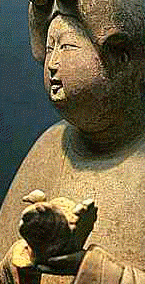 Pan Zhao (48-117?
B.C.E.)
Pan Zhao (48-117?
B.C.E.)
"The only woman to hold the post of official historian to the Imperial Court of the Han Dynasty,
Pan Zhao (Pan Chou) was widowed at an early age. She is the most famous woman scholar of
Chinese history; besides history and poetry she wrote as well a popular
collection of Confucian
Precepts for Women."
Needle and Thread
Tempered, annealed, the hard essence of autumn metals
finely forged, subtle, yet perdurable and straight.
By nature penetrating deep yet advancing by inches
to span all things yet stitch them up together,
Only needle-and-thread's delicate footsteps
are truly broad-ranging yet without beginning!
How can those who count pennies calculate their worth?
They may carve mountains yet lack all understanding.

Hypatia
of Alexandria (370-415 CE)
Hypatia was brutally murdered by the Nitrian monks who were a fanatical sect of
Christians who were supporters of Cyril. According to another account (by Socrates Scholasticus) she was killed by an
Alexandrian mob under the leadership of the reader Peter. What certainly seems indisputable is that she was murdered by
Christians who felt threatened by her scholarship, learning, and depth of scientific knowledge. This event seems to be a turning
point --
Whatever the precise motivation for the murder, the departure soon afterward of many scholars marked the
beginning of the decline of Alexandria as a major center of ancient learning.
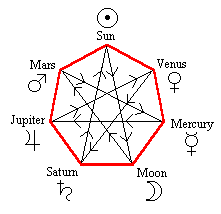
Anna Comnena
/Komnene (1083-bef.1156)
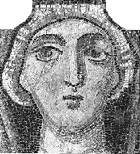
========================================================================
"WHENEVER ONE ASSUMES THE ROLE OF HISTORIAN, FRIENDSHIP AND ENMITIES
HAVE TO BE FORGOTTEN."
========================================================================
Anna Comnena (Greek spelling: Komnene) was born two years after her father, Alexius, had made himself, not
very legitimately, Roman emperor at Constantinople. As Alexius' first-born, she was soon betrothed to the son of
an earlier emperor, the "rightful heir to the throne." In 1092 the engagement was broken off, and Anna's younger
brother was made heir. But it was only after the death of the "rightful heir" that she was married, in 1097, to
Nicephorus Bryennius, the son of a rival of Alexius, with his own claim to the throne.
Whatever the reason, Anna was at some point sent off by her brother John to live in a convent in the city. John died in 1143, to be succeeded by his son Manuel; Anna remained in her convent. Her history of her father's reign seems to have been completed in 1148, but since the end of the manuscript is mutilated, it is hard to be sure.

Mosaic of the Emperor John II Comnenus and the Empress Irene on either side of the Virgin Mary and Child, in the south
gallery of Agia Sophia, Constantinople
(this is Anna's brother, John)
Christine de Pizan 1365 - c. 1430
Most modern feminist scholars date the beginning of the modern feminist movement to the works of Christine de Pizan although they dispute whether her L'Epistre au Dieu d'amours [Letter to the God of Love, 1399], Le dit de la
Rose [The Tale of the Rose, 1402], Epistres du debat sur le Roman de la Rose (Letters on the Debate of The
Romance of the Rose, 1401-1403), or Le Livre de la Cite des Dames [The Book of the City of the Ladies, 1405]
sparked the discussion of the querelle des femmes, the woman question. All four works expanded on and amplified the
ideas in their predecessors.
Letters to the God of Love sparked the debate about the misogynistic The Romance of the Rose which lead
directly to Pizan's 2 entries in the debate, the poetical, The Tale of the Rose, and the verse, Letters on the Debat of
the Rose wherein de Pizan attacked Jean de Meung's popular The Romance of the Rose as immoral and misogynistic.
Continuing the themes developed in her Debate on the Romance of the Rose, a few years later in City of Ladies, de
Pizan presents a dream-vision of a utopian city for women inhabited by powerful, educated, and influential women both
of antiquity and of her own time.
Her father was Tommaso di Benvenuto da Pizzano (Pizzano was a small village in the foothills to the southeast of the
Emilian capital)4, a lecturer in astrology at the University of Bologna (1348) and later physician. Bologna and Paris were leading education centers of the time.
Exactly how Christine was educated and managed to become a professional writer is unclear. We know that her
husband was a royal secretary, a position occupied by the intellectual elite of the time and often the first step in an
illustrious political career. Christine remarked that her father had been well regarded at court and some historians
speculate that he was an adviser to the court librarian on scientific books. Charles V's library was if not the best, then
one of the best, in Europe. Such a position would explain her father's reputation, Christine's access to books, Christine's knowledge of both the printing trade and the best craftsmen in the trade, and Christine's entree into the circles of the rich and
powerful . Unfortunately Charles V died in 1380 when his son and successor, the future Charles VI, was only 12 years of age. Although Charles V had created a regency staffed by his best servants, his powerful brothers did not honor his wishes and many of his servants, including Christine's father, fell on hard
times.
We do know these facts about Christine de Pizan. Educated by her father in spite of her mother's objections,
Christine was happily married at age 15 to Étienne du Castel, royal secretary, who encouraged her to continue her
studies.10 Widowed at age 25 and left with three children, a niece, and her own widowed mother to
support, only now did de Pizan seriously embark on a program of self education. Her father
Her father had died impoverished and her husband's estate took 14 years and numerous lawsuits to
close. De Pizan was France's, and possibly Europe's, first woman known to have earned her living by the pen. Since she was commissioned to writes some of her works, some scholars consider her Europe's first professional writer. While establishing her reputation as a writer, she earned her living by copying and illustrating other people's works.

Courtesans
and Concubines
Yu Xuanji /Yu
Hsuan-chi (c.844-c.871)
========================================================================
"I WISH MY WOMEN'S CLOTHING DIDN'T OBSCURE MY POEMS."
========================================================================
Yu Xuanji (old spelling: Yu Hsuan-chi) was born in Tang China's capital city, Xian. We know nothing of her
family. Tradition says that she first became known as a successful courtesan in the entertainment quarter; she was
then bought as concubine by a provincial government official. He later abandoned her in the south (perhaps at the
insistence of a jealous wife).
Yu Xuanji made her way back to the capital, where she lived for a while in poverty, and then became a Daoist
priestess, probably retiring to a community, but traveling and receiving visitors. She wrote poetry and maintained
literary contacts with other writers: she was believed to be the mentor---perhaps the mistress---of the poet Wen
Tingyun (812-c.870), who, like her, wrote ci /tz'u (poems set to existing music).
At Home In The Summer Mountains
-Yu Xuanji (843?-868)
I've come to the house of the immortals
In every corner, wildflowers bloom.
In the front garden, trees
Offer their branches for drying clothes;
Where I eat, a wine glass can float
In the springwater's chill.
From the portico, a hidden path
Leads to the bamboo's darkened groves.
Cool in a summer dress, I choose
From among heaped piles of books.
Reciting poems in the moonlight, riding a painted boat...
Every place the wind carries me is home.
Ono no Komachi (mid-800s)
========================================================================
"IS THIS LOVE REALITY OR A DREAM?"
========================================================================
Nothing is known about Ono no Komachi except that she belonged to a literary family, was perhaps an attendant
to Emperor Nimmei (d.850), and exchanged poems with some of the major male poets of the mid-800s.
Kokinshu /Kokin wakashu, an imperial anthology completed about 922, contains 18 of her poems; three others
appeared in a later anthology. A 1000's collection of her poetry had 116 poems; it's not clear if all of the
attributions are accurate.
Within a hundred years of her death Ono had become the stuff of legend (see online): most of the stories about her
appear to have been based on her poems, which are about love and the melancholy that it involves. But the
reputation of her poems was such that she was later named as one of Japan's "Six Immortals of Poetry."
Sei Shonagon (965/967-aft.1010)
========================================================================
"EVERYTHING THAT I HAVE SEEN AND FELT IS INCLUDED."
========================================================================
Sei Shonagon's family was literarily but not politically influential. Except for her period at the Japanese court, we
know nothing about her life. She may have been married before she became a court attendant; she may have had a
son.
In 990 she became an attendant to Empress Sadako /Teshi, the daughter of Fujiwara Michitaka. Her name,
"Shonagon" refers to the position she held at court (Minor Counselor); "Sei" is the name of her family. For five
years, Sadako's apartments were the center of the court's cultural activity. However, in 995, Michitaka died, and
his position as the power behind the throne was taken by his brother, Michinaga, who had brought his own
daughter, Shoshi /Akiko, to the Emperor's attention. From then on, Sadako's position became increasingly
insecure, but Shonagon remained with her until Sadako's death in childbirth at the end of 1000.
We have no details of Shonagon's life after 1001: it appears that she began Makura no soshi at court and finished
it after Sadako's death, perhaps as late as 1010, and possibly as a gift for Sadako's daughter.
Makura no soshi (Pillow book) is made up of about 320 separate sections: reminiscences; opinions and
imaginative sketches; and lists, some with comments, others merely lists of words. The datable sections are not in
chronological order, and since the earliest extant manuscript dates from the 1500s, we have no way of knowing if
the current order of the sections represents Shonagon's plan.
The work has always been highly regarded by Japanese readers, and scholars see it as a model of linguistic purity
because it uses few Chinese words. Some think it is a greater work than Genji monogatari, due to its variety and
its compressed language. In any case, it is delightful to read, even in translation, and in it we can hear Shonagon's
distinctive voice.
Things That Make One's Heart Beat Faster:
Sparrows feeding their young. To pass a place where babies are
playing. To sleep in a room where some fine incense has been burnt.
To notice that one's elegant Chinese mirror has become a little cloudy.
To see a gentleman stop his carriage before one's gate and instruct his
attendants to announce his arrival. To wash one's hair, make one's
toilet, and put on scented robes; even if not a soul sees one, these
preparations still produce an inner pleasure.
It is night and one is expecting a visitor. Suddenly one is startled by
the sounds of rain-drops, which the wind blows against the shutters.

see more writers from Dorothy
Disse's site Other
Women's Voices - Writers before 1600
 In
the second class we talked about
In
the second class we talked about 

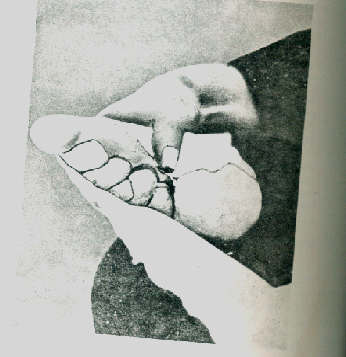
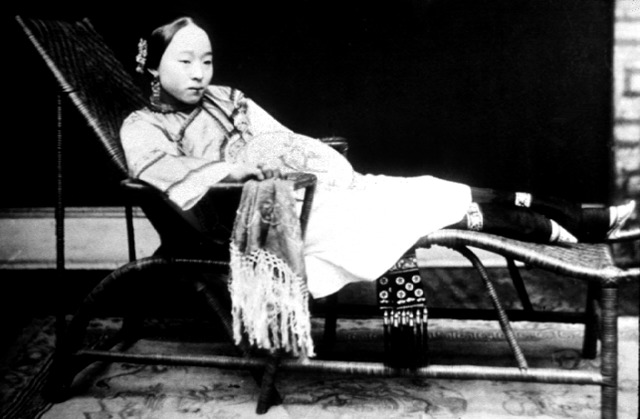
 We have already looked at
We have already looked at 



